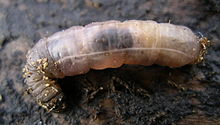Maggot
![]()
This article is about insect larvae. For other meanings, see maggot (disambiguation).
A maggot is a larva of two-winged insects, for example flies. It is distinguished from all other insect larvae by the complete absence of a head capsule and true limbs. Maggot-like, i.e. legless larvae also occur in many other Holometabola orders, for example in bees, ants or longhorn beetles.
Some maggots, such as those of mosquitoes, have stubby feet instead of missing legs, with which they can push themselves over the substrate. Other species living in the substrate have completely lost these locomotor organs and move peristaltically. The mouthparts of these maggots are usually pincer-like mouth hooks located in the pharynx (cephalopharyngeal skeleton, with the pharyngeal ganglion). The body is supported by a more or less solid outer cuticle. Often maggots taper to a point at the front and are particularly broad at the back.
Some biptera, for example Brachycera, are very nimble in laying eggs ("flicking": see flies) on carrion, in the household on meat or cheese, some give birth to maggots (larviparity) or pupae (pupiparity), which is why in former times one preferred to see "evidence" for the constant possibility of primordial generation of organisms here. Here there is also (e.g. in fungus gnats) pedogenesis (maggots or pupae reproduce asexually, without imaginal stage). The maggots of flies usually give rise to barrel pupae (in the soil).
As an adaptation to different ecological requirements, the other characteristics of maggots vary greatly. Among them there are animals that live in mud or water and have developed special breathing tubes (see dung bee). The breathing tubes (tracheae) run through the whole body and end at the rear end of the body. Thus, these maggots can eat and breathe simultaneously while upside down in nutrients. The openings (stigmas) on the breathing tubes are equipped with a special closure mechanism to prevent dirt and water from entering the tracheal system.
Other maggots possess strong jaw hooks and, like cheese fly maggots and flesh fly maggots, live as scavengers in decaying corpses or as parasites on or in living animals (myiasis, botfly maggots). Therefore, they can also occasionally be used specifically in medicine (see maggot therapy). Maggots (and similar larvae) are eaten (roasted) in many places; in Germany, at least in former times, they served as food from vipers that were fastened over fish ponds.
Sometimes maggots occur in large quantities, especially as a "maggot carpet". In these maggot carpets the animals constantly rub against each other, so that on the one hand noticeable warmth and on the other hand an audible noise is produced. The armyworm is a tight cluster of fungus gnat larvae moving together.
To cure inflammation maggots are also used. Especially in chronic injuries in diabetics, they can often clean wounds better and faster than conventional means, when inflammation occurs in poorly perfused areas, where antibiotics inadequate dosage.
Maggots are an essential food source for many species of animals, such as tits and woodpeckers.

A maggot isolated from its substrate
Search within the encyclopedia